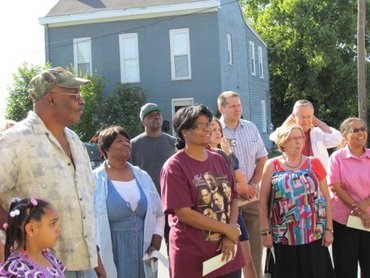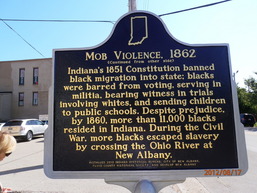 Mob Violence, 1862 Marker Dedication
Did you miss the dedication of our newest Indiana State Historical Marker? Read about the event in WIBC's story and check out our photos of the event!
 |
|
Detail of "Mob Violence, 1862," dedicated on August 18, 2012. |
 Local historian Pam Peters speaks at the dedication.
|
 After the marker is unveiled, visitors tour the former Israel boarding house.
|
The fifth time's a charm
The "Indianapolis Times" State Historical Marker (Marion County) was originally placed in 1979, and it's had more than its fair share of incident reports since then. In 2005, the marker was hit by a motorist and damaged. After repair and reinstallation, the marker was broken from its post during the NCAA Final Four in 2006. It was repaired and reinstalled in the Fall of 2007. Then, the post sustained damage and had to be replaced in the Spring of 2008. In the Fall of the same year, the marker was again broken from its cap, after the Colts lost to the Chicago Bears in a home game.
Researchers at IHB have been working on a new text for the pending replacement, as the new double-sided format adopted in recent years allows for more information to be shared. Former Indianapolis Times reporters are assisting IHB with the new text. The Indiana Historical Bureau is working to secure a safer location for this replacement marker. Stay tuned!
How do we know when a marker like "Indianapolis Times" is damaged? Our staff pass a few Indianapolis markers on their daily commute, but for the most part, we rely on people like you to let us know. Get involved today. |